Themed collection Physical chemistry of hybrid perovskite solar cells

Physical chemistry of hybrid perovskite solar cells
Hybrid perovskite solar cells were first reported in 2009 by Miyasaka and co-workers (J. Am. Chem. Soc., 2009, 131, 6050) and sparked an exciting change in photovoltaics research, a field that has been growing rapidly ever since.
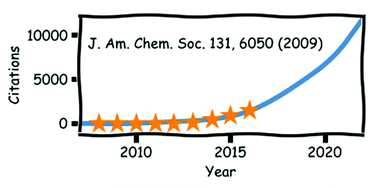
Phys. Chem. Chem. Phys., 2016,18, 27024-27025
https://doi.org/10.1039/C6CP90212J
Strategic improvement of the long-term stability of perovskite materials and perovskite solar cells
This review provides a comprehensive overview of the recent strategies aimed at enhancing the long-term stability of perovskite materials and perovskite solar cells (PSCs). It also extensively discusses the stability problem of perovskite materials and PSCs from perspectives of experimental tests and theoretical calculations.
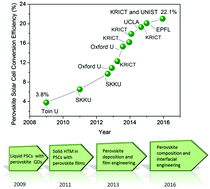
Phys. Chem. Chem. Phys., 2016,18, 27026-27050
https://doi.org/10.1039/C6CP04553G
Hole-conductor-free perovskite solar cells with carbon counter electrodes based on ZnO nanorod arrays
ZnO/TiO2 NR array is a novelty candidate as an electron collector for hole-conductor-free perovskite solar cells with carbon counter electrodes.

Phys. Chem. Chem. Phys., 2016,18, 27078-27082
https://doi.org/10.1039/C6CP04793A
How to regulate energy levels and hole mobility of spiro-type hole transport materials in perovskite solar cells
meta-Substitution is more beneficial to reduce HOMO levels compared with ortho- and para-substitution, while the hole mobility can be improved by ortho-substitution.

Phys. Chem. Chem. Phys., 2016,18, 27073-27077
https://doi.org/10.1039/C6CP03316D
Dynamic disorder, phonon lifetimes, and the assignment of modes to the vibrational spectra of methylammonium lead halide perovskites
Raman and THz spectra of CH3NH3PbX3 interpreted with a catalogue of computed vibrations and their influence on heat and electrical transport.

Phys. Chem. Chem. Phys., 2016,18, 27051-27066
https://doi.org/10.1039/C6CP03474H
Low temperature synthesis of hierarchical TiO2 nanostructures for high performance perovskite solar cells by pulsed laser deposition
High aspect-ratio TiO2 nanostructures directly assembled with pulsed laser deposition could improve interfacial contact for superior perovskite photovoltaic cells.
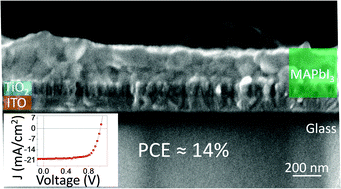
Phys. Chem. Chem. Phys., 2016,18, 27067-27072
https://doi.org/10.1039/C6CP02896A
Electronic and optical properties of MAPbX3 perovskites (X = I, Br, Cl): a unified DFT and GW theoretical analysis
The electronic properties of the MAPbX3 halide perovskites are investigated by DFT and GW methods, revealing the trends in band structure and optical properties along the X = I, Br and Cl series.
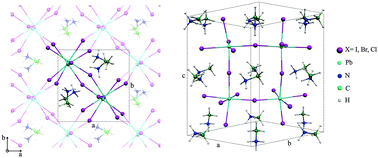
Phys. Chem. Chem. Phys., 2016,18, 27158-27164
https://doi.org/10.1039/C6CP03969C
Influence of the mixed organic cation ratio in lead iodide based perovskite on the performance of solar cells
Perovskite solar cells were fabricated using the mixed organic cation of formamidinium and methylammonium. The mixed cation having the composition MA0.6FA0.4PbI3 shows almost negligible I–V hysteresis and better photostability than pure MAPbI3 and FAPbI3.
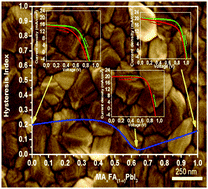
Phys. Chem. Chem. Phys., 2016,18, 27148-27157
https://doi.org/10.1039/C6CP03851D
Understanding of the formation of shallow level defects from the intrinsic defects of lead tri-halide perovskites
For the organic–inorganic hybrid perovskites, the longer Pb–halide bond distance and the smaller band gap are the key factors to determine the shallow level energy formation of the intrinsic defects.

Phys. Chem. Chem. Phys., 2016,18, 27143-27147
https://doi.org/10.1039/C6CP02886A
Multinuclear NMR as a tool for studying local order and dynamics in CH3NH3PbX3 (X = Cl, Br, I) hybrid perovskites
We report on 207Pb, 79Br, 14N, 1H, 13C and 2H NMR experiments for studying the local order and dynamics in hybrid perovskite lattices.
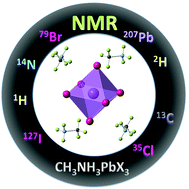
Phys. Chem. Chem. Phys., 2016,18, 27133-27142
https://doi.org/10.1039/C6CP02947G
Structural and electronic features of small hybrid organic–inorganic halide perovskite clusters: a theoretical analysis
We herein present the results of a series of calculations performed on some representative cluster models of hybrid organic–inorganic halide perovskites, (MA)jPbkXl (l = 2j + k; MA = methylammonium, +CH3NH3; X = halide).
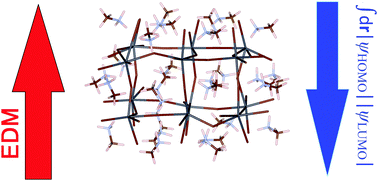
Phys. Chem. Chem. Phys., 2016,18, 27124-27132
https://doi.org/10.1039/C6CP03193E
An efficient perovskite solar cell with symmetrical Zn(II) phthalocyanine infiltrated buffering porous Al2O3 as the hybrid interfacial hole-transporting layer
An interfacial buffer layer made of Al2O3 and sym-HTPcH facilitates perovskite solar cells with an average PCE value of 12.3%.
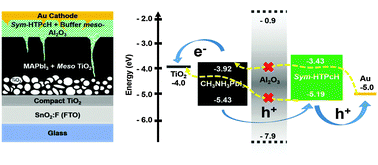
Phys. Chem. Chem. Phys., 2016,18, 27083-27089
https://doi.org/10.1039/C6CP03396B
Light stability tests of CH3NH3PbI3 perovskite solar cells using porous carbon counter electrodes
Strong moisture-blocking effect by CH3NH3PbI3 perovskite-porous carbon layer has been found.
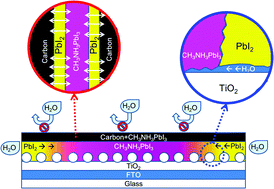
Phys. Chem. Chem. Phys., 2016,18, 27102-27108
https://doi.org/10.1039/C6CP03388A
A close examination of the structure and dynamics of HC(NH2)2PbI3 by MD simulations and group theory
Rotational dynamics of formamidinium in FAPbI3 and mixed displacive/order–disorder instabilities investigated by MD simulations and group theory.
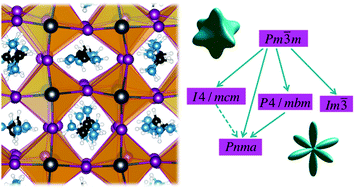
Phys. Chem. Chem. Phys., 2016,18, 27109-27118
https://doi.org/10.1039/C6CP02917E
Modulating carrier dynamics through perovskite film engineering
The one-sentence summary that highlights the novelty of our work is, “morphology-kinetics studies on substrate/film-treated perovskite samples reveal that the highly effective toluene-wash processes surprisingly increase trap density in CH3NH3PbI3 films”.
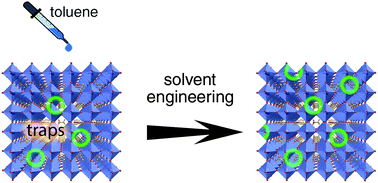
Phys. Chem. Chem. Phys., 2016,18, 27119-27123
https://doi.org/10.1039/C6CP02640K
How photon pump fluence changes the charge carrier relaxation mechanism in an organic–inorganic hybrid lead triiodide perovskite
The fluence dependent charge carrier relaxation dynamics in a FAPbI3 polycrystalline thin film were measured using femtosecond transient absorption and terahertz spectroscopies.
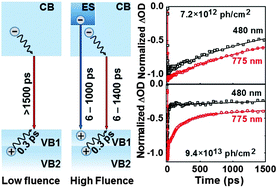
Phys. Chem. Chem. Phys., 2016,18, 27090-27101
https://doi.org/10.1039/C6CP02682F
About this collection
A themed collection dedicated to the physical chemistry and chemical physics of perovskite solar cells, Guest Edited by Aron Walsh, Nitin P. Padure and Sang Il Seok.